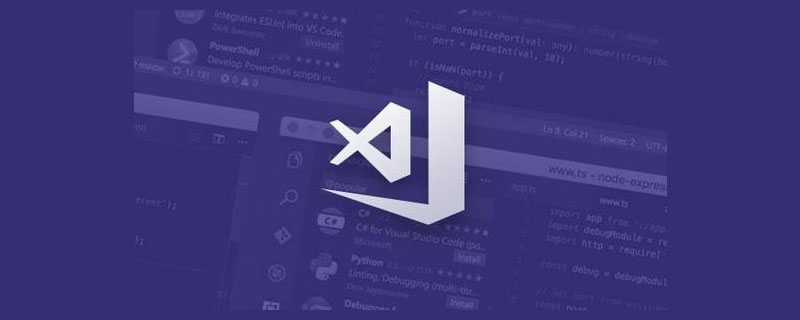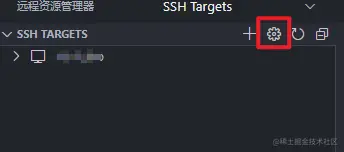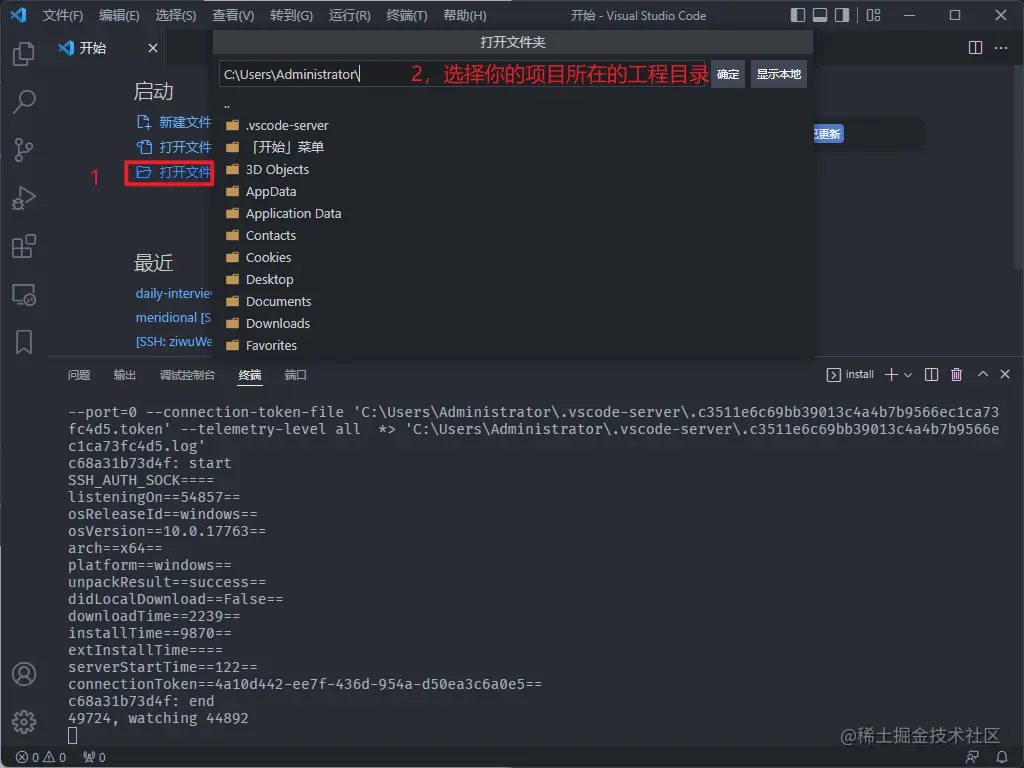 Development Tools
Development Tools
 VSCode
VSCode
 Detailed explanation of how to configure SSH server in VSCode for remote development
Detailed explanation of how to configure SSH server in VSCode for remote development
Detailed explanation of how to configure SSH server in VSCode for remote development
This article will talk about VSCode remote development and introduce how to gain a super comfortable remote development experience through SSH and VSCode. I hope it will be helpful to everyone!

Write in front
Recently the company has an outsourcing project that requires remote development, whether it is using remote control software It's still Microsoft's Remote Desktop Connection, the experience is not very good, it feels very uncomfortable, especially Microsoft's Remote Desktop Connection, which can only be used by one person, often occurs The phenomenon of you squeezing me and I squeezing you reminds me that I used SSH to remotely connect to Linux for development a year ago. This time I will remotely connect to Windows for development.
The device version is as follows:
Remote control computer: Win11
Remote controlled computer: Win10
VSCode version: 1.67.2
Remote - SSH version: 0.80.0
【Recommended Study: "vscode introductory tutorial"]
Configuring SSH server
First we need to install an OpenSSH server, if it is a Win10 system If so, the installation is relatively simple. The steps are as follows:
The first step is to open [Settings], shortcut key [Win i], find [Applications] → [Applications and Features] → [Manage Optional Features] 】Enter;

The second step is to install the OpenSSH server. If the OpenSSH server exists in the list, it means the installation has been successful. Otherwise, click [Add Function] and then find the OpenSSH server. Install;

# During the installation, a progress bar will appear below, just wait patiently.

If you prefer the command line installation, first open PowderShell as an administrator, and then execute the following commands in sequence
# 获取SSH软件名称 Get-WindowsCapability -Online | ? Name -like 'OpenSSH*'
The output results are as follows:
Name : OpenSSH.Client~~~~0.0.1.0 State : NotPresent Name : OpenSSH.Server~~~~0.0.1.0 State : NotPresent
The first one represents the SSH client, and the second one represents the SSH server
We install the SSH server here. Win10 installs the SSH client by default. The installation command is as follows :
Add-WindowsCapability -Online -Name OpenSSH.Server~~~~0.0.1.0
The output content is similar to the following, indicating that the installation is successful
Path : Online : True RestartNeeded : False
The third step is to start the SSHD service. We need to open the PowerShell command name and enter the following command:
Start-Service sshd
The fourth step is to set the service to start automatically.
Set-Service -Name sshd -StartupType 'Automatic'
The last step is to configure SSH in the firewall. You only need to copy the following command into PowerShell:
if (!(Get-NetFirewallRule -Name "OpenSSH-Server-In-TCP" -ErrorAction SilentlyContinue | Select-Object Name, Enabled)) { Write-Output "Firewall Rule 'OpenSSH-Server-In-TCP' does not exist, creating it..." New-NetFirewallRule -Name 'OpenSSH-Server-In-TCP' -DisplayName 'OpenSSH Server (sshd)' -Enabled True -Direction Inbound -Protocol TCP -Action Allow -LocalPort 22 } else { Write-Output "Firewall rule 'OpenSSH-Server-In-TCP' has been created and exists." }SSH Connecting to the server
Now we use the SSH command on our own computer to connect to the WIndows server we configured before. No matter whether your device is Mac, Windows or Linux, you can connect as long as you have the ssh command. .
Here I am using Win11, the command is as follows:
ssh administrator@0.0.0.0
The administrator here represents the user name, 0.0.0.0 represents the server ip address.
After completing the input, you need to enter yes first and then enter the password to connect successfully.

Connect through Remote-SSH
Finally, we implement remote development through Remote-SSH, an extension of VSCode. The steps are as follows:
The first step: Install the Remote-SSH extension, just search and install it directly. It looks like this:

The second step is to open [Remote Resources Manager】

The third step is to hover the mouse over [SSH TarGETS] and click [Settings]

Step 4: Click on this configuration file

Step 5: Configure:
# Read more about SSH config files: https://linux.die.net/man/5/ssh_config
Host alias # 别名,可以随便写
HostName 0.0.0.0 # 远程连接的ip地址
User Administrator # 远程连接的用户名Step 6, click on the connection, which is the picture below Step 7: Select the little icon of the system

We will choose whatever system it is

Eight steps: Enter the server password and wait

The last step is to open the project directory for development

The configuration is now complete.
Written at the end
This article records the process of how to turn a Windows into an SSH server and connect through the SSH command and develop it in VSCode , if it is helpful to you, you can like and collect to avoid not finding it in the future~
For more related knowledge about VSCode, please visit: vscode tutorial!
The above is the detailed content of Detailed explanation of how to configure SSH server in VSCode for remote development. For more information, please follow other related articles on the PHP Chinese website!

Hot AI Tools

Undresser.AI Undress
AI-powered app for creating realistic nude photos

AI Clothes Remover
Online AI tool for removing clothes from photos.

Undress AI Tool
Undress images for free

Clothoff.io
AI clothes remover

Video Face Swap
Swap faces in any video effortlessly with our completely free AI face swap tool!

Hot Article

Hot Tools

Notepad++7.3.1
Easy-to-use and free code editor

SublimeText3 Chinese version
Chinese version, very easy to use

Zend Studio 13.0.1
Powerful PHP integrated development environment

Dreamweaver CS6
Visual web development tools

SublimeText3 Mac version
God-level code editing software (SublimeText3)

Hot Topics
 1669
1669
 14
14
 1428
1428
 52
52
 1329
1329
 25
25
 1273
1273
 29
29
 1256
1256
 24
24
 How to define header files for vscode
Apr 15, 2025 pm 09:09 PM
How to define header files for vscode
Apr 15, 2025 pm 09:09 PM
How to define header files using Visual Studio Code? Create a header file and declare symbols in the header file using the .h or .hpp suffix name (such as classes, functions, variables) Compile the program using the #include directive to include the header file in the source file. The header file will be included and the declared symbols are available.
 What computer configuration is required for vscode
Apr 15, 2025 pm 09:48 PM
What computer configuration is required for vscode
Apr 15, 2025 pm 09:48 PM
VS Code system requirements: Operating system: Windows 10 and above, macOS 10.12 and above, Linux distribution processor: minimum 1.6 GHz, recommended 2.0 GHz and above memory: minimum 512 MB, recommended 4 GB and above storage space: minimum 250 MB, recommended 1 GB and above other requirements: stable network connection, Xorg/Wayland (Linux)
 How to solve the problem of vscode Chinese annotations becoming question marks
Apr 15, 2025 pm 11:36 PM
How to solve the problem of vscode Chinese annotations becoming question marks
Apr 15, 2025 pm 11:36 PM
How to solve the problem that Chinese comments in Visual Studio Code become question marks: Check the file encoding and make sure it is "UTF-8 without BOM". Change the font to a font that supports Chinese characters, such as "Song Style" or "Microsoft Yahei". Reinstall the font. Enable Unicode support. Upgrade VSCode, restart the computer, and recreate the source file.
 vscode terminal usage tutorial
Apr 15, 2025 pm 10:09 PM
vscode terminal usage tutorial
Apr 15, 2025 pm 10:09 PM
vscode built-in terminal is a development tool that allows running commands and scripts within the editor to simplify the development process. How to use vscode terminal: Open the terminal with the shortcut key (Ctrl/Cmd). Enter a command or run the script. Use hotkeys (such as Ctrl L to clear the terminal). Change the working directory (such as the cd command). Advanced features include debug mode, automatic code snippet completion, and interactive command history.
 Where to write code in vscode
Apr 15, 2025 pm 09:54 PM
Where to write code in vscode
Apr 15, 2025 pm 09:54 PM
Writing code in Visual Studio Code (VSCode) is simple and easy to use. Just install VSCode, create a project, select a language, create a file, write code, save and run it. The advantages of VSCode include cross-platform, free and open source, powerful features, rich extensions, and lightweight and fast.
 Common commands for vscode terminal
Apr 15, 2025 pm 10:06 PM
Common commands for vscode terminal
Apr 15, 2025 pm 10:06 PM
Common commands for VS Code terminals include: Clear the terminal screen (clear), list the current directory file (ls), change the current working directory (cd), print the current working directory path (pwd), create a new directory (mkdir), delete empty directory (rmdir), create a new file (touch) delete a file or directory (rm), copy a file or directory (cp), move or rename a file or directory (mv) display file content (cat) view file content and scroll (less) view file content only scroll down (more) display the first few lines of the file (head)
 vscode Previous Next Shortcut Key
Apr 15, 2025 pm 10:51 PM
vscode Previous Next Shortcut Key
Apr 15, 2025 pm 10:51 PM
VS Code One-step/Next step shortcut key usage: One-step (backward): Windows/Linux: Ctrl ←; macOS: Cmd ←Next step (forward): Windows/Linux: Ctrl →; macOS: Cmd →
 vscode terminal command cannot be used
Apr 15, 2025 pm 10:03 PM
vscode terminal command cannot be used
Apr 15, 2025 pm 10:03 PM
Causes and solutions for the VS Code terminal commands not available: The necessary tools are not installed (Windows: WSL; macOS: Xcode command line tools) Path configuration is wrong (add executable files to PATH environment variables) Permission issues (run VS Code as administrator) Firewall or proxy restrictions (check settings, unrestrictions) Terminal settings are incorrect (enable use of external terminals) VS Code installation is corrupt (reinstall or update) Terminal configuration is incompatible (try different terminal types or commands) Specific environment variables are missing (set necessary environment variables)



